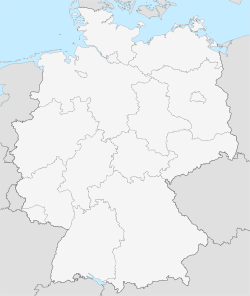Erding
| Erding | |
| Coat of arms | Location |
 |
 |
| Administration | |
| Country | Germany |
|---|---|
| State | Bavaria |
| Admin. region | Upper Bavaria |
| District | Erding |
| Mayor | Maximilian Gotz (CSU) |
| Basic statistics | |
| Area | 54.64 km² (21.1 sq mi) |
| Elevation | 463 m (1519 ft) |
| Population | 33,519 (30/03/2007) |
| - Density | 613 /km² (1,589 /sq mi) |
| Other information | |
| Time zone | CET/CEST (UTC+1/+2) |
| Licence plate | ED |
| Postal code | 85435 |
| Area code | 08122 |
| Website | www.erding.de |
Erding is a town in Bavaria, Germany, and capital of the district Erding. It had a population of 34,122 in 2004. It is twinned with Bastia in Corsica
The original Erdinger Weissbier is a well-known Bavarian specialty. Grünbacher is one of the better-known local brands. Due to the nearby Munich Airport and Amadeus data center, both of which employ people from many countries, Erding has quite an international feel, despite its relatively small size.
Erding is located around 45 kilometers (28 miles) northeast of central Munich, about a 40-minute drive by car. Regular S-Bahn trains connect to Munich and beyond. Munich is accessible by bike lanes, although it's slightly too far for regular commutting except for enthusiasts.
Contents |
Erding Timeline
Most of the information in this timeline is taken from the book “Landkreis Erding”, available from the Erding public library. This book was published in 1985, so it predates the time when the Munich Airport was built on the nearby Erdinger Moos (wetland). I also translated some of the information on the Landkreis Erding website to fill in some gaps.
Approx 1 million B.C. Glaciers during the Riss Ice age reach their most Northern point in Southern Bavaria near Erding.
Approx 9000 BC Neolithic (New Stone Age) spread of humans to the Inntal region of the Alps and beyond into the region now called Bavaria.
Approx 6000 B.C Belongings of Hunter/Gatherers in the Erding area dating to this time are the first indications of human habitation found so far. Individual finds of relics from Erding region area include an axe made of deer horn.
Approx 2500 B.C Excavations of 2 dwellings of at least 6.5 metres in length near Altenerding from this period are the first evidence of permanent agricultural based inhabitants
1800 B.C. Successful excavation of approx 20 Early Bronze Age graveyards from this period in Langenpriesing.
1188 A.D. The Wittlesbacher Duchy is created as a reward for Otto VI. von Wittlesbach-Wartenberg for loyalty to Kaiser Friedrich I. Barbarossa. This land award includes the settlement later to be known as Erding.
1228 – 1230 The city of Erding is founded. Erding develops as a township after it becomes an alternative route from Landshut to Munich. Erding becomes known as a border town, midway between the two rival towns.
1632 & 1634 During the 30 year’s war, Erding was taken twice by Swedish Forces, who plundered it and set it on fire.
1789 A census in Erding at this time shows Erding with a population of 1700. It had 4 blacksmiths and 4 saddlers, 8 tailors and shoemakers, 3 rope makers, 2 hat makers, 11 pubs, 11 butchers, 11 bakers, and 11 professional musicians, according to the records.
1886 Johann Kienle opens the towns first brewery.
1936 The Fliegerhorst military airport nearby central Erding was opened.
1945 Several air raids on the nearby military airport are made towards the end of the Second World War by allied forces, damage to buildings in Erding and civilian casualties are considerable. The air raid on 18.04.1945 hit the town especially hard with 144 deaths. Control of this airport is given to the American forces after the war – which immediately exposes the local populace to a whole new way of thinking after the Nazi years.
1957 Control of the Fliegerhorst airbase is passed back to German authorities. Since that time this base has been a small but active base – occasionally jets will quite fly low and loud over Erding during training exercises.
1972 Erding is connected to the Munich’s S-Bahn network. This makes Erding more attractive as a place to live, because it places it within the Munich commuter belt.
1978 Erding has its 750 year birthday celebrations.
1986 Last Airshow at the Fliegerhorst.
1992 Franz Josef Strauss Airport – more commonly known as Munich airport – opens. The decision to build a major airport on the ecologically sensitive Erdinger Moos was a source of controversy for the previous decade. The airport has attracted new businesses and additional population to the area since it was opened.
Agriculture in Erding
Farm fields surround Erding and large agricultural vehicles are a common sight on local roads. Local crops include corn for animal feed, wheat, sunflowers, carrots, white/red/blue/green cabbages, strawberries, kohlrabi, turnips, and sugar beet. Farm animals are normally kept in stables and are mostly limited to pigs, chickens and cows. Fish farming in privately owned lakes is also practised. Gardening is also practiced in Erding, but is limited by the relatively cool climate.
Erding's farmers tend to be conservative Catholics, unlike the younger portion of the population.
Some Images of Erding
External links
- Herbstfest Erding Local Beer Festival (10 Days)
- Oktoberfest München Munich Oktoberfest (16 Days)
- Sinnflut Festival
- TSV Erding 1862 e.V.
- Flughafen München Munich Airport
- Münchner Verkehrs- & Tarifverbund Munich Transport & Tariff Association
- Hotel in München
|
|||||||